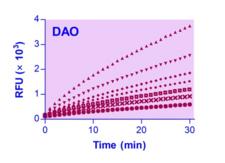order histories, retained contact details for faster checkout, review submissions, and special promotions.
Forgot password?
order histories, retained contact details for faster checkout, review submissions, and special promotions.
Locations
Orders Processing,
Shipping & Receiving,
Warehouse
2 Shaker Rd Suites
B001/B101
Shirley, MA 01464
Production Lab
Floor 6, Suite 620
20700 44th Avenue W
Lynnwood, WA 98036
Telephone Numbers
Tel: +1 (206) 374-1102
Fax: +1 (206) 577-4565
Contact Us
Additional Contact Details
order histories, retained contact details for faster checkout, review submissions, and special promotions.
Forgot password?
order histories, retained contact details for faster checkout, review submissions, and special promotions.
AOC1
amine oxidase, copper containing 1
Catalyzes the degradation of compounds such as putrescine, histamine, spermine, and spermidine, substances involved in allergic and immune responses, cell proliferation, tissue differentiation, tumor formation, and possibly apoptosis. Placental DAO is thought to play a role in the regulation of the female reproductive function.
| Gene Name: | amine oxidase, copper containing 1 |
| Synonyms: | AOC1, ABP, ABP1, DAO1, Histaminase, Kidney amine oxidase, KAO, Diamine oxidase |
| Target Sequences: | NM_001091 NP_001082.2 P19801 |

If you do not find the reagent or information you require, please contact Customer.Support@LSBio.com to inquire about additional products in development.









